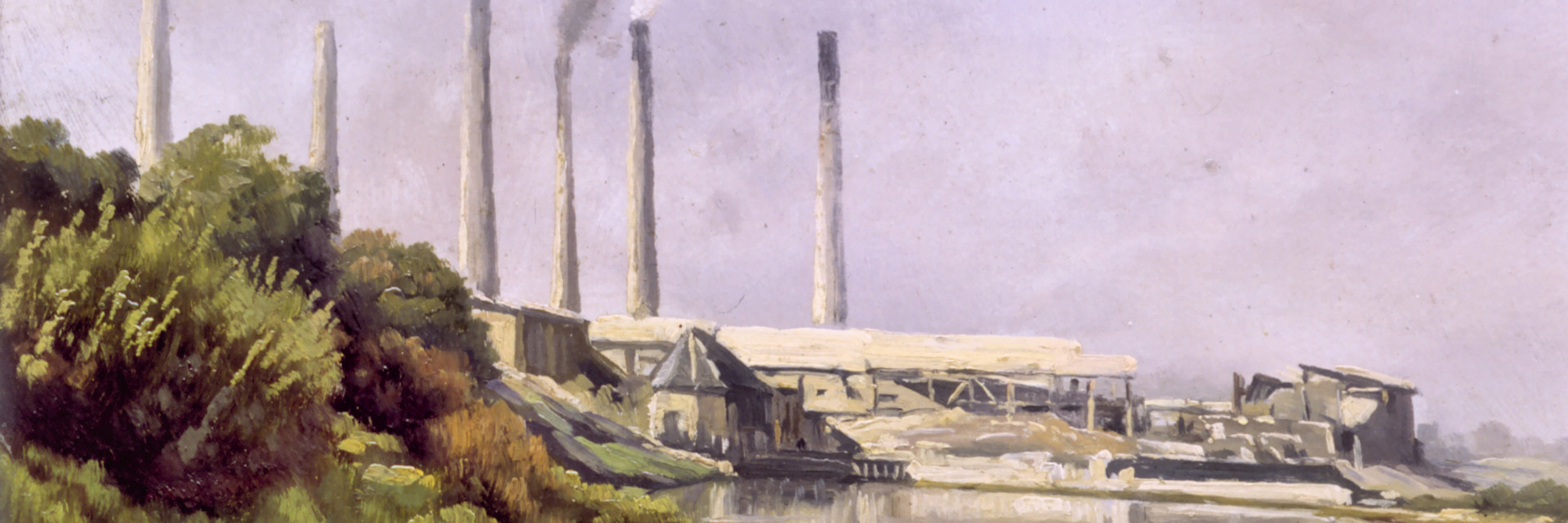Drawing of the Bergheim Mill by Philibert von Graimsberg, ca. 1870
Site plan of the Heidelberg factory on the Neckar, 1885
Watercolour of the Heidelberg Work from the East by Max Wolf, 1895
Johann Philipp Schifferdecker
A new cement is invented
The invention of Portland cement in England in 1824 brought a new binder onto the market, which differed significantly in its processing properties from the roman cements and hydraulic limes that had been common until then. From the 1840s, Portland cement was available in smaller quantities at high prices. This encouraged numerous investors, also on the mainland, to reinvent English cement. In the 1860s, the first larger factories appeared, often built and operated by people unfamiliar with the subject.
A beer brewer becomes a cement manufacturer
One of these entrepreneurs was the beer brewer Johann Philipp Schifferdecker. He came from a large Mosbach family with 24 children. Like his ancestors, he learned the craft of beer boiling. His mother died in September 1835, barely of age. In 1838, when a maternal uncle offered him the prospect of his own brewery in Königsberg, he took advantage of the opportunity. As early as 1849 he was able to set up a large-scale operation in Ponarth. However, his three children had no interest in the brewery, so he left the management of the business to his youngest brother. At the age of 56, he made the decision to sell shares in the brewery and to build up an existence for his son, who had a doctorate in chemistry in Heidelberg.
Foundation of the Portland cement plant in Heidelberg and the joint stock company
It is not known how Johann Philipp became aware of Portland cement, but there is a legend about it. The Heidelberg location offered the necessary prerequisites in terms of available raw materials. A building site for the factory buildings was still missing. The Bergheim Mill in Heidelberg was run by Johann Martin Conrad Reiffel at the time. Several attempts to avert insolvency failed, so that the mill with outbuildings and extensive land could be bought at auction by Schifferdecker on 2 January 1873. After one and a half years, the mill started operations, but soon threatened to fail for lack of expertise. The young cement chemist Friedrich Schott finally succeeded in eliminating the problems and leading the company to success.
Fire disaster and migration to Leimen
Meanwhile, Johann Philipp returns to Königsberg and devotes himself to Freemasonry, among other things. After his death in 1887, his descendants converted the company into a joint stock company, which has since been listed on the Frankfurt Stock Exchange. After two decades of steady growth, the factory was badly damaged by a major fire in 1895. It was rebuilt in Leimen near the quarries. There, the largest cement factory in the German Empire was built according to Schott's plans. The addition "formerly Schifferdecker & Söhne" can still be found in the company name, but it disappears soon after the first merger with the Mannheim Portland Cement Factory in 1901.
The descendants of the Schifferdecker family
Johann Philipp's son, Johann Paul, was plant manager for a time, but died shortly after his father. His youngest sister, Friederike Helene Antonie, was married to Rudolf Heubach, who was also a founder. Friederike rebelled in the family and married two more times to very opposite personalities. Her sister Maria Olga Luise was married to the merchant Gustav Schmidt, who, like Heubach, sat on the supervisory board. Heubach also died early in 1895, so that after the great fire the founding generation had also left. The Heubach family emigrated to England via Bonn. Among the descendants are well-known landscape painters.
- Heidelberg’s Portland cement-makers: articles on the company’s history and corporate culture, issue 14
-
Johann Philipp Schifferdecker and his Family Beer brewer and cement pioneer
[published by HeidelbergCement AG]
Dietmar Cramer, Eszter Harsányi - HeidelbergCopyright © 2022 HeidelbergCement AG
Berliner Straße 6, 69120 HeidelbergCover photo: Johann Philipp Schifferdecker, 1875.
Layout/Design and Realisation: Unternehmensarchiv Heidelberg Materials
Translation: Kurt Armstrong - Sydney


